The CGS Group Hyperion has lead the industry in .30 cal sound suppression prowess for years thanks to its unique, patented internal structure. Now, with the advent of metal 3D printing (called DMLS, or direct metal laser sintering), CGS has been untethered to create internal geometries that are impossible to machine. Upgraded and quieter than ever, the new CGS Hyperion and Hyperion K have just hit the market, and we went hands-on . . .
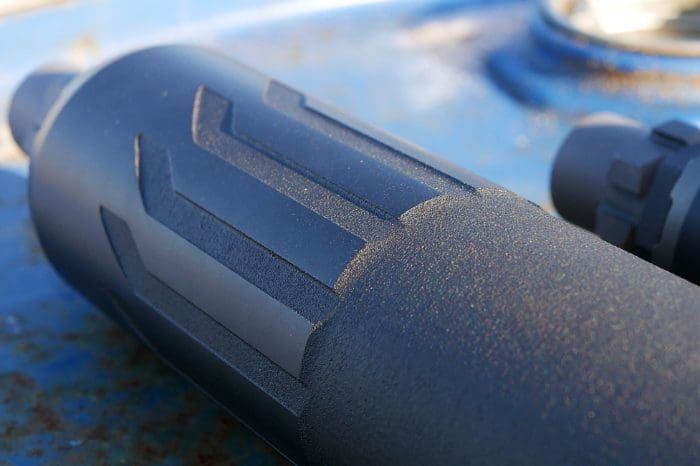
Each of the new .30 caliber Hyperions is made entirely of DMLS titanium. The “3D printing” process involves depositing a fine layer of Ti dust then using a powerful laser to sinter, or melt/fuse/weld, this new layer to the previous layer in only the precisely desired places. Then another layer of dust, another pass of the laser, and repeat until your end product is built one teeny micro-fraction-of-an-inch layer at a time. Unsintered Ti dust can be blown out as needed during the build process in order to prevent it from becoming trapped inside internal structures.
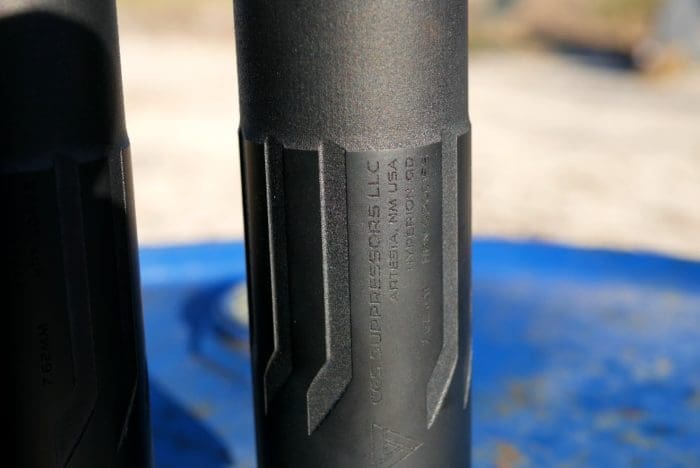
Believe it or not, what you end up with is a truly monolithic end product that actually has a more consistent, finer metal grain structure with fewer (like, zero) metallurgic imperfections than you find inside a forged or cast product, or a product that’s machined from a billet / forging or casting.
Left raw, the layer-by-layer process is visible if you look closely enough; especially on angled surfaces (see below). If machined, you’d never know.
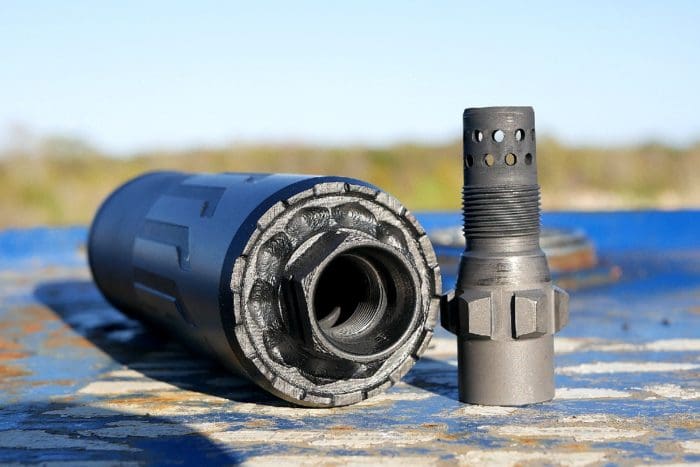
Both of the new Hyperions employ a 25-degree taper section before the mounting threads. If you’re installing a Hyperion on your SIG SAUER (creators of the 25-degree tapered shoulder) or a firearm that borrowed the SIG taper design, go ahead and thread the suppressor directly onto the barrel. That taper will provide a fantastic, full gas seal along with massively increased mating surface area, which does wonders to help prevent the suppressor from coming loose during use.
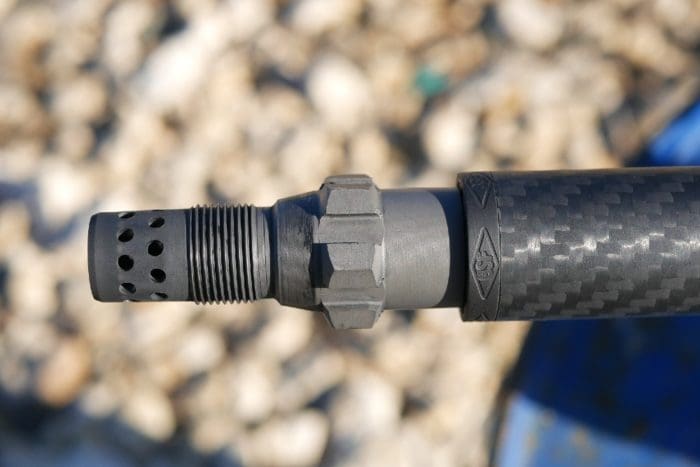
On most barrels with a standard, square shoulder, you will likely want to run CGS’ new Hyperion Thread Adapter. Available in both 5/8×24 and 1/2×38, the thread adapters effectively convert your square-shouldered muzzle into a taper-shouldered muzzle, throwing the required 5/8×24 threads out in front of the taper.
[EDIT: CGS informed us that the mount portion of the production Hyperion (these two cans were pre-production, but there are no other changes other than to the mount area) is fine for use on square barrel shoulders as long as the shoulder is over 0.735 inches in diameter. Due to the taper section inside the Hyperion’s mount you engage about 0.380 inches of muzzle threads rather than about 0.495 inches as you would on a suppressor without an internal taper, but that this sufficient for nearly every use. The thread adapters are handy regardless, as they bring the locking and sealing benefits of the taper to a square shoulder barrel (suggested to thread locker the adapter to the barrel), and they also allow the use of the suppressor on a skinny barrel that lacks a sufficient shoulder, because the muzzle of the barrel is designed to bottom out inside of the thread adapter.]
The thread adapters also include a small compensator that diffuses gases even more rapidly upon entering the Hyperion. In fact, given their diminutive size they work better as stand-alone muzzle compensators than you’d probably expect. Not that Hyperion owners are likely to ever shoot unsuppressed.

Near the base of the thread adapter is a neat looking wrench flat feature that will accept a deep socket, box wrench, adjustable wrench, or possibly even 12-point wrench. It’s the same size as the wrench flats on the base of the Hyperion and Hyperion K.
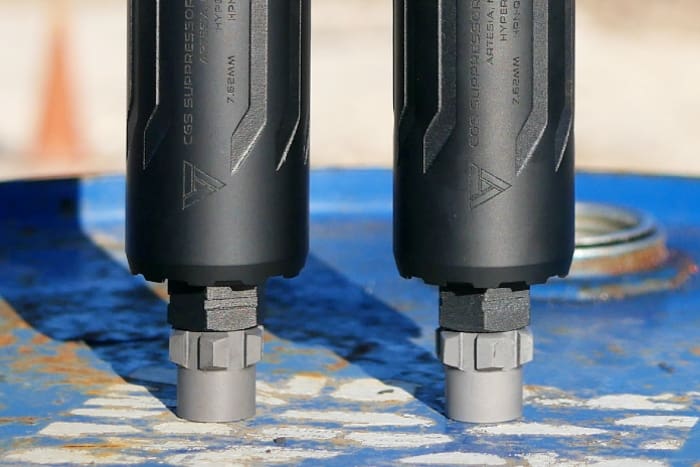
If I have any complaint about these CGS suppressors, it’s the additional 0.8 inches of length that’s brought to the table by the thread adapters. Every millimeter is necessary to make this adapter function, but I’m not so enamored by a tapered muzzle that I’d necessarily choose the extra length over a suppressor designed for a standard barrel with square shoulder. The taper is better at providing a full gas seal and preventing the suppressor from coming loose, I’m just not sure it’s 0.8 inches better, ya know?
Obviously the absolute best case scenario here is using the CGS Hyperion on a tapered shoulder barrel and forgoing the extra component and its extra length. That said, the 1/2×28-threaded adapter is a great way to run a .30 cal suppressor on a 5.56 or other, smaller-than-.30-caliber firearm with 1/2×28 threads.
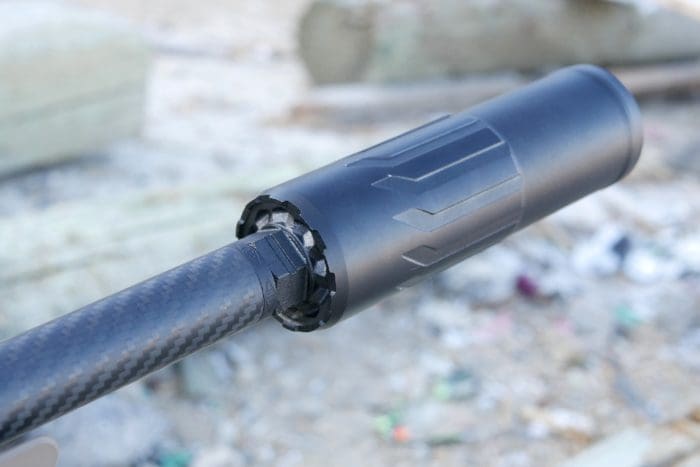
Now all this said, you can run the Hyperion FS or Hyperion K on a square-shouldered barrel. You’ll get about 3 and 3/4 rotations worth of thread engagement before it’s tight. This is enough to use (especially for a limited firing schedule, such as when hunting), but it isn’t ideal. Installed on the Hyperion Thread Adapter there’s about 7 rotations of the suppressor before it’s tight.
[EDIT: again, CGS contacted us to state that the suppressors tested here have a slightly different mount design than the production ones, which allow for more thread engagement (~0.380 inches of engagement, to be precise) on a standard, square-shouldered barrel and that they are perfectly well-suited to being run on a square-shouldered barrel as long as the shoulder is at least 0.735 inches in diameter. If smaller, use a Hyperion Thread Adapter.]
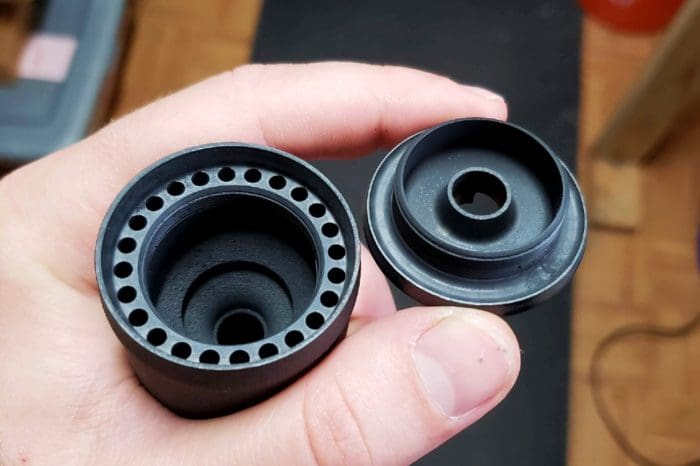
Both of the new Hyperions ship with a low-profile front end cap. This front cap seals off the coaxial, outer flow path gases.
A vented front end cap will be available soon and, as you’ve guessed, it will vent those outer flow gases right out the front of the suppressor. This sort of lower backpressure, “flow-through” suppressor style may be preferable on a semi-automatic firearm where gas and noise out the ejection port is every bit as much of a concern as it is from the muzzle.
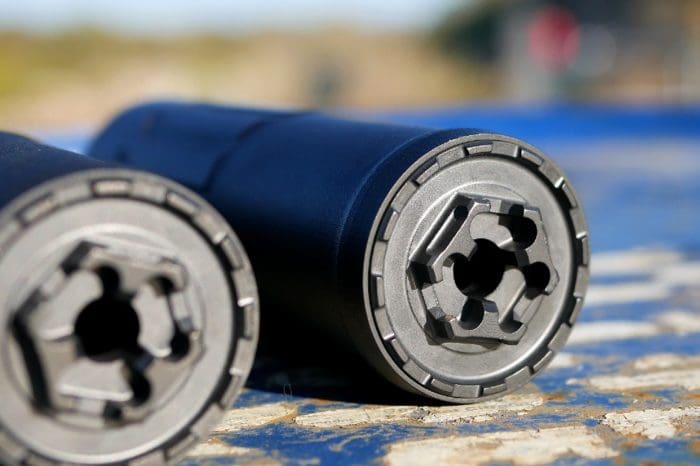
In fact, allowing more pressure venting at the muzzle of a suppressed, semi-automatic firearm will often decrease the volume level experienced at the shooter’s ears, even though it will increase the volume level at the muzzle of the gun. On a manual action firearm, however, the solid end cap is almost certainly going to provide more sound suppression everywhere.
Those radial holes hidden by the front cap of the Hyperion hint at the complicated geometry inside. The Hyperion’s coaxial outer flow path is similar to what’s seen in the cutaway drawing of CGS’s first DMLS suppressor, the Helios, seen above (and in this patent). A version of this has always existed within the Hyperion, but the 3D printing process has allowed for some cool new tricks and gas pathways to take form.
Perhaps the most critical feature — at least as far as I can tell and am aware of — is how the coaxial outer flow merges back with the main axial flow (the gas going down the bore) approximately halfway down the suppressor. I have no idea if the K maintains this merge feature at approximately the same ~halfway point along its length, or if it merges close to its front cap and is effectively identical to the full-size flavor up to that point in the printing process.
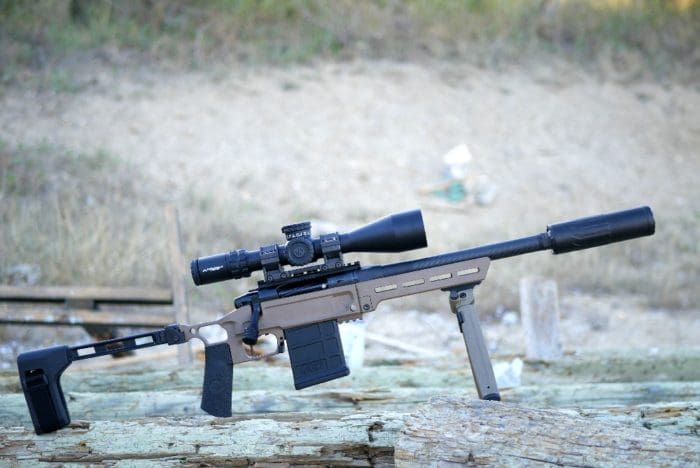
A 12-inch 6.5 Creedmoor likely isn’t the intended host for the short little Hyperion K, but I figured why not throw it right into the deep end and see what it’s capable of on this Black Collar Arms Pork Sword Pistol.
Tone was deep, recoil reduction was great, and volume level was touching up against the point of discomfort. I’d run the K on this setup for hunting, perhaps, when I’d expect to carry the gun for hours and hours and fire it likely once if all goes to plan. For practice and sighting in, I’d rock light ear protection.
Again though, this is a short barrel firing a cartridge that arguably doesn’t suppress quite as nicely as .308 Winchester does within the same barrel length.
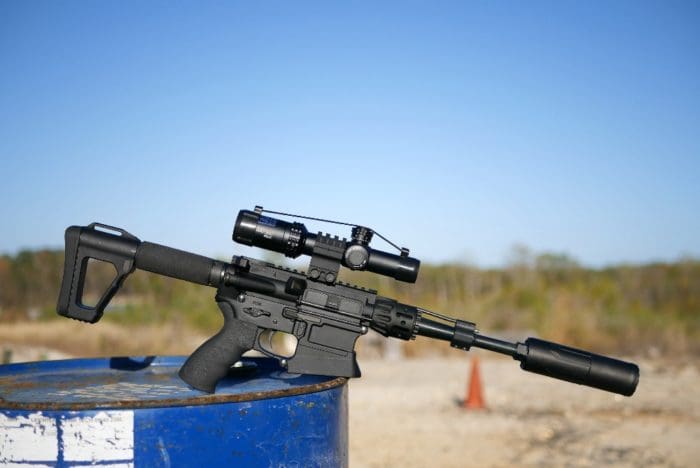
On my 8.3-inch 300 Blackout, the Hyperion K was really impressive for its size. I felt like the noise from the ejection port and from the action cycling was just as loud as the gunshots themselves.
At the shooter’s ear, this wouldn’t be a surprise with a decent suppressor. What is a surprise is just how quiet the K is despite its short 6.3-inch length and light 10.2-ounce weight. Most “decent suppressors” with this level of sound suppression performance are going to be at least 8 inches long.
All of this was borne out lately by PEW Science in their Sound Signature Review of the Hyperion K. By way of example, the Hyperion K’s Suppression Rating at the muzzle is about 42% better than that of the Q Trash Panda (which is longer and heavier than the Hyperion K, and which I like a lot). Heck, the K is only about 10% shy of matching the Suppression Rating of the SilencerCo Omega-300 and handily beats out the Rugged Radiant in its long configuration.
This is just raw sound suppression, mind you, and there are lots of other important considerations when choosing a suppressor, but suffice it to say that the Hyperion K packs a lot of noise reduction into a compact, lightweight package.

Switching over to the full-length Hyperion, which is a 9.5-inch-long silencer, and we’re now into the realm of “quietest .30 cal silencer on the market” levels of sound suppression. The original Hyperion, from everything I saw, read, and experienced personally, was probably the quietest .30 caliber suppressor out there, and it has now been beaten by the new, “3D printed” version tested here.
Despite the full-size length, the Hyperion FS weighs in at only 15.6 ounces. It’s an inch longer but just over an ounce lighter than my Dead Air Sandman-Ti, which I have always considered a very quiet, pleasant-sounding, top-notch suppressor. But the Hyperion absolutely crushes it on sound reduction. At the ear or at the muzzle, it is absolutely an outlier in the market in just how incredibly quiet it is. For solid comparison data, I once again suggest you head over to PEW Science’s test results.
Back to the 12-inch Pork Sword Pistol launching 120 grain 6.5 Creedmoor slugs downrange at about 2,450 FPS, the Hyperion makes this a most pleasant experience. I feel like more noise came back at me from the berm 25 yards downrange than from the gun. I’ve shot suppressors with a deeper tone, but holy heck is the CGS Hyperion quiet.
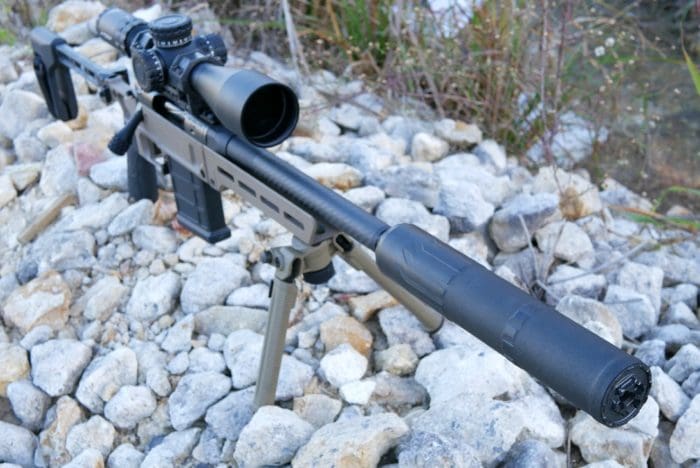
On my 300 Blackout SBR (which I apparently neglected to photograph with the Hyperion FS attached), quiet doesn’t even begin to describe it. Perhaps “silencer” is coming close to a legitimately descriptive term here when shooting subsonic ammo.
If not for the action noise, we’re really scratching up against that “Hollywood quiet” sort of situation. All hyperbole aside, between the noise made by the action — especially the bolt clanging back into battery — and the sound of the bullet hitting the berm I was practically unable to hear the gunshot itself. CGS Group’s new full-size Hyperion mated to a 300 BLK shooting subs is silly, ridiculously quiet.
https://youtu.be/T4q9CQjVfFg
Thanks to that 1/2×28 thread adapter I was also able to test both the Hyperion FS and Hyperion K on an AR-15 firing standard .223 Remington ammo. And by “AR-15” I mean that select-fire machine gun I made on the cheap-o polymer lower. So, sure, the Hyperions got a brief, full-auto workout. CGS said I should try to keep ’em under 800 degrees but, otherwise, get at it.
So get at it I did, and the results were great. Most .30 cal suppressors do a decent job on 5.56 / .223, and the Hyperions did decent and then some. I was pleased by the lack of gas to the face and, while I was wearing ear plugs for this bit of testing, I could hear enough to recognize that this setup was quieter than with the previous two .30 cal cans I shot on this same 14.5-inch gun with this same ammo.
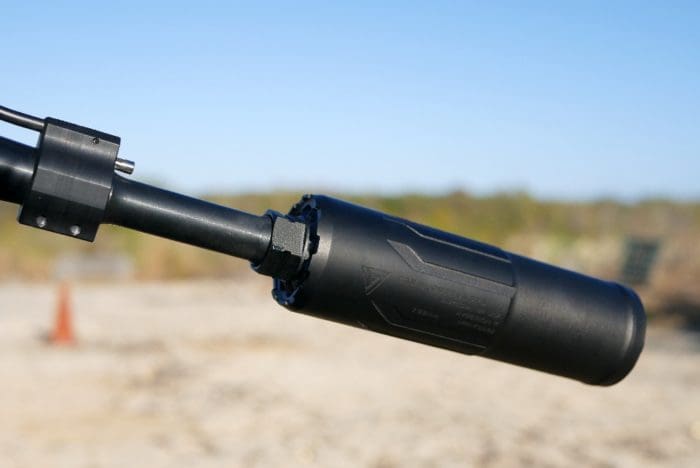
With a patented core and baffle design and DMLS titanium construction, the new CGS Hyperion and Hyperion K are arguably the most advanced silencers on the market today. And thanks to the work being done by PEW Science, we know the Hyperion is the quietest .30 cal suppressor they’ve ever tested — by a healthy margin — and I suspect it’s the quietest available, period. We’ve also seen that the Hyperion K is punching well out of its size and weight class.
While I’m split on the choice of mounting style, it’s a well-designed, solid system that allows for use on all types of muzzles (including on effectively shoulderless muzzles like on the SCAR or Tavor with the use of a Hyperion Thread Adapter) and provides an easy way to run this .30 cal can on a 1/2×28 barrel.
Generally speaking I’d choose those now-industry-standard 1.375×24 mount threads for use with all sorts of different mounting systems, but in the case of the Hyperion the coaxial outer flow geometry begins within the base of the suppressor and it just wouldn’t work with a removable base system that accepts other mounts. CGS’ mount design provides solid utility and it’s a good solution, taking the taper design to the next level by offering thread adapters for square shouldered barrels.
MSRP is definitely on the high end of the market, but it’s hard to argue with the performance of the CGS Hyperions and the ability to swap end caps to effectively tune the suppressors to the host firearm’s gas flow needs. Not to mention the very slick, S-Line finish that prevents carbon build-up and increases durability.
Hit up Silencer Shop to find out more on the Hyperion and Hyperion K and to find a dealer near you.
Specifications: CGS Hyperion and Hyperion K
Caliber: .30 caliber (if it fires a 0.308-inch or smaller projectile, you’re almost certainly good to go)
Length: 9.5 inches and 6.3 inches
Weight: 15.6 ounces and 10.2 ounces
Diameter: 1.75 inches
Material: DMLS grade 5 titanium
Finish: S-Line and DLC
MSRP: $1,379 for the Hyperion, $1,129 for the Hyperion K. (Silencer Shop’s prices will be lower)
Ratings (out of five stars):
Utility * * * *
I’m forced to knock a star off the Hyperion’s rating here, because not going with that 1-3/8×24 universal mounting size necessarily means restricting dozens of great mounting options from use. However, the Hyperion still rates above average due to its ability to smoothly transition between square shoulder and taper shoulder barrels and between 5/8×24 and 1/2×28 threads (and on barrels that effectively lack any shoulder) with the use of the Hyperion Thread Adapters. The Hyperions also score points for multiple front end cap designs that change the functionality of the gas flow within the suppressor, allowing the end user to adjust for the needs of a manual action vs. a semi-automatic firearm.
Form Factor * * * *
The new CGS Hyperion and Hyperion K are good looking silencers, indeed. The deepest, darkest, richest jet black of the S-Line and/or DLC finish is fantastic. I’m knocking off a star for the extra length and the long, skinny mount appearance that the thread adapters bring to the equation, though. They’re optional in many cases, of course, and useful in other cases, I just wish they didn’t add nearly an inch to the total length. (Production thread adapters are black to match the suppressors, by the way)
Suppression * * * * *
The CGS Hyperion FS is literally the quietest .30 caliber silencer on the market, and the Hyperion K without a doubt outperforms for its size.
Overall * * * * 1/2
If you’re seeking the best sound suppression available, the Hyperion is a five-star silencer without a doubt, whatsoever. Nothing beats it and it likely isn’t even particularly close. Ultimately I’m rating the Hyperions at four-and-a-half stars, though, primarily because of the barrier to entry that the high MSRP is going to provide for a lot of folks. They’re fantastic suppressors that can be put to use on all sorts of different host firearms — literally anything firing a 0.308-inch or smaller projectile, effectively — and I don’t for a second think that CGS’ MSRP is unfair or out of line, but damn it’s still a lot of skrilla. I’m also not personally convinced that the taper mount is the best option, but CGS has done a really good job making it useful and near-universal.


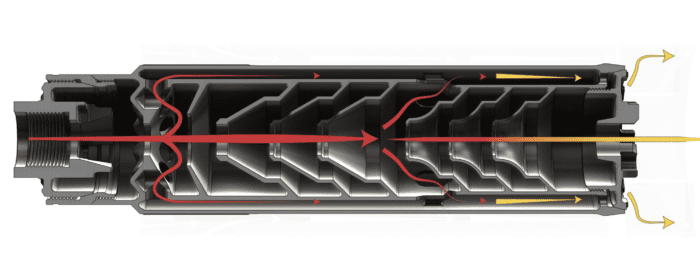



Test?
you shared is very reasonable. I will note the reasons you give. Thanks very much.
I thought Jeremy moved to Texas a couple years ago?
“He lives in Eastern WA not far from N’Idaho”
And nice review.
I did, yeah. Didn’t realize that little bio showed up anywhere and forgot it existed 😆. That’s from inside the user account thing. Started showing up with this new site theme. Updated!
Jeremy, on the 5.56 full auto testing did you adjust the gas between K and full size testing? It seems like the K ejected to 1:30ish while the full size was more like 3:00, which is sort of the opposite you’d expect when adding more can out front.
I’m really interested in the full size Hyperion on an 11.5 Super Duty w/ H3, but non-adjustable gas. That is at least until they release the Helios QD Ti.
Comments are closed.